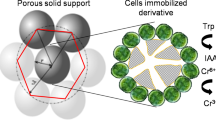Summary
Growth and death of anchorage-independent animal cells entrapped within porous biomass support particles (BSPs) in static or shake-flask cultures were evaluated by comparison of enzyme activity with non-immobilized cells grown under static culture using 3-(4,5-dimethylthiazol-2-yl)-2,5-diphenyl tetrazolium bromide (MTT) assay and release of lactate dehydrogenase into the culture medium. Mouse myeloma MPC-11 (ATCC CCL 167) cells inoculated within porous polyvinyl formal resin BSPs (3 × 3 × 3 or 2 × 2 × 2 mm; mean pore diameter, 60 μ ) grew exponentially at a specific growth rate comparable to that of non-immobilized cells in the initial period of incubation. Entrapped cells then reached the stationary phase with a cell density over 107 cells/cm3 BSP. The death rate of entrapped cells increased in response to the rise in viable cell density in the BSPs. Observation of viable cell distribution within the BSPs using MTT staining indicated that the cells concentrated within a thin outer shell of the BSPs with time. After the immobilized cells reached the stationary phase, penetration of cells into the outer shell ceased and heterogeneous distribution of cell density occurred in the viable cell layer in the shake-flask culture.
Similar content being viewed by others
References
Al-Rubeai M, Spier R (1989) Quantitative cytochemical analysis of immobilised hybridoma cells. Appl Microbiol Biotechnol 31:430–433
Al-Rubeai MA, Musgrave SC, Lambe CA, Walker AG, Evans NH, Spier RE (1990a) Methods for the estimation of the number and quality of animal cells immobilized in carbohydrate gels. Enzyme Microb Technol 12:459–463
Al-Rubeai MA, Rookes S, Emery AN (1990b) Studies of cell proliferation and monoclonal antibody synthesis and secretion in alginate-entrapped hybridoma cells. In: Bont JAM de, Visser J, Mattiasson B, Tramper J (eds) Physiology of immobilized cells. Elsevier Science Publishers, Amsterdam, pp 181–188
Atkinson B, Black GM, Lewis PJS, Pinches A (1979) Biological particles of given size, shape, and density for use in biological reactors. Biotechnol Bioeng 21:193–200
Denizot F, Lang R (1986) Rapid colorimetric assay for cell growth and survival: modifications to the tetrazolium dye procedure giving improved sensitivity and reliability. J Immunol Methods 89:271–277
Gardner AR, Gainer JL, Kirwan DJ (1990) Effects of stirring and sparging on cultured hybridoma cells. Biotechnol Bioeng 35:940–947
Mosmann T (1983) Rapid colorimetric assay for cellular growth and survival: application to proliferation and cytotoxicity assays. J Immunol Methods 65:55–63
Murakami H, Masui H, Sato GH, Sueoka N, Chow TP, Kano-Sueoka T (1982) Growth of hybridoma cells in serum-free medium: ethanolamine is an essential component. Proc Natl Acad Sci USA 79:1158–1162
Posillico EG (1986) Microencapsulation technology for large-scale antibody production. Bio/Technology 4:114–117
Racher AJ, Looby D, Griffiths JB (1990) Use of lactate dehydrogenase release to assess changes in culture viability. Cytotechnology 3:301–307
Wohlpart D, Gainer J, Kirwan D (1991) Oxygen uptake by entrapped hybridoma cells. Biotechnol Bioeng 37:1050–1053
Yamaji H, Fukuda H (1991) Long-term cultivation of anchorage-independent animal cells immobilized within reticulated biomass support particles in a circulating bed fermentor. Appl Microbiol Biotechnol 34:730–734
Yamaji H, Fukuda H, Nojima Y, Webb C (1989) Immobilisation of anchorage-independent animal cells using reticulated polyvinyl formal resin biomass support particles. Appl Microbiol Biotechnol 30:609–613
Author information
Authors and Affiliations
Rights and permissions
About this article
Cite this article
Yamaji, H., Fukuda, H. Growth and death behaviour of anchorage-independent animal cells immobilized within porous support matrices. Appl Microbiol Biotechnol 37, 244–251 (1992). https://doi.org/10.1007/BF00178179
Received:
Accepted:
Issue Date:
DOI: https://doi.org/10.1007/BF00178179




